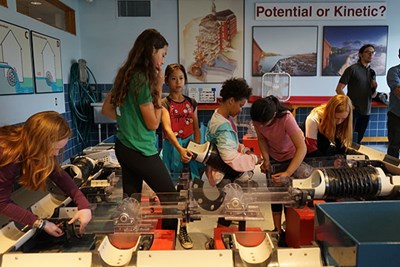Professors Hit High Note with Teaching Amid Crisis

03/25/2020
By David Perry
Music may have the power to soothe, but for more than a week, those who teach it have been scrambling to adjust to the new reality of COVID-19 and online instruction.
While adapting his classes as online lessons, Prof. John Shirley decided to weave in some normalcy and walked to South Campus, camera in hand.
“I walked around taking pictures of the academic and social spaces my students have grown so accustomed to at UMass Lowell,” says Shirley. “When I went live with my first class, I used the green screen features in Zoom to make it look like I was greeting them from various places on campus.”
In the Music Department, everything, from student auditions to ensemble classes and practices, has become a virtual production. Setting it up can be a technical feat. Last week, Shirley moved three classes online, including his Blues Ensemble class, which had been scheduled to host a March 24 blues jam at the downtown eatery Warp & Weft before falling victim to virus-related cancellations.
“I was hell-bent on setting up a space to do pro-level, multichannel, multiscreen recording, livestreaming and conferencing of real-time instruction, as well as recording lectures, tutorials and demos for students to watch online whenever they please,” he says.
Shirley retrofitted a campus lab facility with two digital audio mixers, professional quality multichannel audio interfacing, multiple microphones, instruments, a guitar amp, two-channel video and adjustable video lighting.
And then he had to recreate it all off campus, in a spare bedroom at home, when it became clear that classrooms were closing down for the semester. His virtual classroom is “up and running, with some tweaking still to do.”
Traditionally, auditions for music majors happen in person in the spring, but they’ve been shifted to the virtual world, says Prof. Gena Greher, interim chair of the Music Department.
“We will be creating an online portal for students to submit audition videos,” says Greher. “The actual parameters of the audition requirements will remain unchanged for the most part. However, they are being asked to submit an unedited video of their performance of two contrasting pieces, some scales, some examples of pitch matching (playing a note and singing it back), along with telling us about themselves and why they think our program is a good fit for them.“
The upside of the shift, Greher says, is video “might mitigate some performance anxiety that often occurs in a live audition.” Also, faculty can review videos at their convenience.
Greher notes, however, that video auditions have their limitations.
“Not seeing how well they respond to suggestions will give us a slightly narrower view of a student’s potential,” she says. “Students are sending their video into cyberspace and don’t get a feel for who we are, either. That human touch will be missing.”
Greher points out that video auditions aren’t without precedent. “We do this often for students who live too far away to audition in person, and professional organizations use video submissions,” she says.
But performance gets exponentially more difficult with larger groups of classroom students.
“Ensembles are particularly tricky to do online,” says Shirley. “Sound quality and latency/timing issues are just the beginning. The nuance of the immediate interaction and subtle cues between players, and the energy that grows between audience and performer, are not possible.”
Those who teach the largest gatherings of student musicians are adapting to keeping students together, in sync.
“We certainly have challenges,” says Debra Huber, associate director of University Bands and director of Instrumental Music Outreach. “Large ensembles are not something that can be scaled down. For example, I rehearse a 75-instrument concert band. It’s not feasible with the technology that currently exists to be able to rehearse together in a large ensemble setting.
“Students need to hear and react to one another, to alter and adjust pitch based upon what they are hearing, to articulate – to speak – in the exact same way at the same time. There is no affordable, large-scale technology that exists to make this happen right now,” she says.
“One of the most important aspects of performance is learning the proper interpretive dialects, the spoken language of music,” says Dan Lutz, director of University Bands. “Notes on the page provide basic data, but the idiom and language – classical, jazz, rock, funk, Latin – and the hundreds of different dialects of each of these languages is what breathes humanity into the minimalist symbols.”
College band directors “have never faced this kind of extraordinary challenge, filled with such unknown, where we have had to drastically change what we do. It literally seemed like everything turned on a dime,” says Huber.
Fortunately, say both Huber and Lutz, marching band takes place during the fall semester. In the meantime, Huber is having students work “individually on items and aspects of the music. It does not in any way replace what the ensemble is. Nor does it fulfill the ultimate mission of a large ensemble, which cannot be done without real-time collaboration between student and conductor and peers.
“The most impressive thing has been how fast we’ve all suddenly spun in a new direction and have continued moving ahead,” says Huber. “Everyone is doing what they can to figure it out – how to teach in a new environment, how to quickly figure out what can still be taught or now be taught to enhance students’ musical learning in a productive and still relevant way that remains educationally sound and relevant to the class or ensemble.
“We are finding a new normal in the moment, while continuing to look ahead to what things will be once again.”


